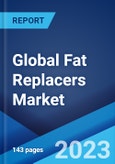The global fat replacers market size reached US$ 2.9 Billion in 2022. Looking forward, the market is expected to reach US$ 3.7 Billion by 2028, exhibiting a growth rate (CAGR) of 4.14% during 2022-2028.
Fat replacers are nonfat substances that provide a taste and texture similar to high-fat foods but with fewer calories. They are made from starchy foods, such as corn, cereals, and grains, or by modifying egg white or whey from milk, or replacing triglycerides in vegetable oils. They are incorporated into a variety of food products like frozen desserts, processed meats, cheese, and sour cream to lower the fat content. They can also be found in baked goods, yogurt, margarine, salad dressing, sauces, gravies, snack chips, and various ready-to-eat (RTE) items.
Fat replacers are nonfat substances that provide a taste and texture similar to high-fat foods but with fewer calories. They are made from starchy foods, such as corn, cereals, and grains, or by modifying egg white or whey from milk, or replacing triglycerides in vegetable oils. They are incorporated into a variety of food products like frozen desserts, processed meats, cheese, and sour cream to lower the fat content. They can also be found in baked goods, yogurt, margarine, salad dressing, sauces, gravies, snack chips, and various ready-to-eat (RTE) items.
Fat Replacers Market Trends
The escalating demand for reduced-fat and fat-free food items on account of changing dietary patterns, rising health concerns, and increasing willingness among individuals to accept fat substitutes represents one of the key factors impelling the market growth. Moreover, fat replacers offer a safe and effective means of maintaining the palatability of food while promoting calorie control and weight loss and maintenance. This, in confluence with the increasing focus on weight-loss strategies and the rising health consciousness among individuals, is driving the demand for fat replacers across the globe. Apart from this, fat replacers, coupled with a healthy lifestyle, can effectively combat obesity and its complications. They also assist in decreasing hemoglobin A1c (HbA1c), lowering lipid levels and systolic blood pressure, and reducing the risk of cardiovascular diseases (CVDs) and type 2 diabetes. In addition, they aid in increasing high-density lipoprotein (HDL) levels and improving glucose tolerance. Thus, the growing prevalence of obesity and chronic diseases, along with the increasing awareness about the benefits of fat replacers, is creating a positive influence on the demand for fat replacers across the globe.Key Market Segmentation
This research provides an analysis of the key trends in each sub-segment of the global fat replacers market report, along with forecasts at the global, regional and country level from 2023-2028. The report has categorized the market based on type, source, form and application.Breakup by Type:
- Carbohydrate
- Protein
- Lipid
Breakup by Source:
- Plant
- Animal
Breakup by Form:
- Liquid
- Powder
Breakup by Application:
- Processed Meat
- Bakery and Confectionery
- Beverages
- Convenience Food
Breakup by Region:
- North America
- United States
- Canada
- Asia-Pacific
- China
- Japan
- India
- South Korea
- Australia
- Indonesia
- Europe
- Germany
- France
- United Kingdom
- Italy
- Spain
- Russia
- Latin America
- Brazil
- Mexico
- Middle East and Africa
Competitive Landscape
The competitive landscape of the industry has also been examined along with the profiles of the key players being Archer-Daniels-Midland Company, Ashland, Cargill Incorporated, Corbion N.V., CP Kelco U.S. Inc. (J.M. Huber Corporation), DuPont de Nemours Inc., Fiberstar Inc., Ingredion Incorporated, Kerry Group plc, Koninklijke DSM N.V., Tate & Lyle PLC and Ulrick & Short.Key Questions Answered in This Report:
- How has the global fat replacers market performed so far and how will it perform in the coming years?
- What has been the impact of COVID-19 on the global fat replacers market?
- What are the key regional markets?
- What is the breakup of the market based on the type?
- What is the breakup of the market based on the source?
- What is the breakup of the market based on the form?
- What is the breakup of the market based on the application?
- What are the various stages in the value chain of the industry?
- What are the key driving factors and challenges in the industry?
- What is the structure of the global fat replacers market and who are the key players?
- What is the degree of competition in the industry?
Table of Contents
1 Preface3 Executive Summary12 Value Chain Analysis14 Price Analysis
2 Scope and Methodology
4 Introduction
5 Global Fat Replacers Market
6 Market Breakup by Type
7 Market Breakup by Source
8 Market Breakup by Form
9 Market Breakup by Application
10 Market Breakup by Region
11 SWOT Analysis
13 Porters Five Forces Analysis
15 Competitive Landscape
Companies Mentioned
- Archer-Daniels-Midland Company
- Ashland
- Cargill Incorporated
- Corbion N.V.
- CP Kelco U.S. Inc. (J.M. Huber Corporation)
- DuPont de Nemours Inc.
- Fiberstar Inc.
- Ingredion Incorporated
- Kerry Group plc
- Koninklijke DSM N.V.
- Tate & Lyle PLC
- Ulrick & Short
Methodology

LOADING...
Table Information
| Report Attribute | Details |
|---|---|
| No. of Pages | 143 |
| Published | November 2023 |
| Forecast Period | 2022 - 2028 |
| Estimated Market Value ( USD | $ 2.9 Billion |
| Forecasted Market Value ( USD | $ 3.7 Billion |
| Compound Annual Growth Rate | 4.1% |
| Regions Covered | Global |
| No. of Companies Mentioned | 12 |









